
Station Name: LIVERPOOL MOORFIELDS
|
| Date opened: | 2.5.1977 (Northern Line platforms) |
| Location: | Main entrance on the east side of Moorfields. |
| Company on opening: | British Rail (London Midland Region) |
| Date closed to passengers: | Still open |
| Date closed completely: | Still open |
| Company on closing: | Still open |
| Present state: | Still open |
| County: | Lancashire |
| OS Grid Ref: | SJ343906 |
| Date of visit: | 23.5.2011 |
Notes: Moorfields station is located in the city of Liverpool’s business district and is situated on an underground part of the Merseyrail network. The station serves the loop line used by trains from the Wirral, and the link line which connects the former CLC (Cheshire Lines Committee) line to Hunts Cross with the former L&YR lines to Southport, Ormskirk and Kirkby. The station was built as a replacement for the former L&YR terminus Liverpool Exchange. The idea for creating underground linking lines through the city can be traced back to the early 20th Century, but the genesis of the loop and link lines in the form that they eventually took was in studies carried out in the 1960s, principally the MALTS (Merseyside Area Land Use Transportation Study) of 1966. Further momentum was gained in 1969 when the MPTE (Merseyside Passenger Transport Executive) was formed with the remit of overseeing bus, rail and ferry services. In 1971 it obtained an Act to build the loop and link lines and branded the network Merseyrail. Three distinct groups of lines were created:
The electric trains of the Wirral and Northern lines had Merseyrail branding applied along with the MPTE logo. Work began on the loop and link lines on 28th July 1975. A section of the original Mersey Railway tunnel between Central and James Street was used in the link line. Under Paradise Street a junction was created with two single-bore tunnels to carry the link through to the former L&YR lines. It was on the section of single bore tunnels that Moorfields station was located. The situation at Moorfields was complex because the Queensway Road Tunnel opened in 1934 passes beneath the site of the station as does the 6ft diameter Dale Street sewer. The loop line tunnel had to pass under the Queensway tunnel whilst the link had to pass over it. The sewer in turn had to pass over the link line tunnel. Amongst all of this a passenger railway station with interconnecting passages that had to provide access between the platforms, up to the street at Moorfields and up to the street at Old Hall Street had to be accommodated. The solution was to provide two underground cross passages, the shallower one passing over the link line and extended at both ends so that it reached escalator tunnels that linked with Moorfields at one end and Old Hall Street at the other. The other passage passed under the link line, well clear of the Queensway Road Tunnel, and linked to a lower triple escalator that gave access to the low level platform at one end and at the other end shorter escalators linked to the Link Line Platform. Connecting it to the higher level passage was a further escalator shaft. As the loop line was a single track only one platform was needed to serve the deep level Wirral Line. The link line however was a double track route. As previously explained through Moorfields each line was in its own single bore tunnel and a platform was provided in each linked by cross passages. This gave Moorfields three platforms. At street level on Moorfields the booking office was located high above the pavement. This was because the City Council had a vision to create aerial walkways above the city streets which it believed pedestrians would use keeping them away from the traffic below. Some sections of the route were built but it was a failure and the idea was dropped. The last sections of the walkways that were built were demolished in the 1990s. The main entrance to Moorfields was left looked very odd and not as assessable to its users as it might have been. The street level entrance at Old Hall Street was at pavement level and was far more accessible. Booking facilities were located in both street level entrances. The station was an immediate success: the loop and link lines created a surge in passenger numbers.
On 3rd January 1978 part of the CLC route out as far as Garston reopened as an electrified line. It became part of the Northern Line, despite being in the south of the city. Kirkby services were extended to terminate at Garston. (Southport and Ormskirk trains continued to terminate at Central.) On 25th October 1978 H M Queen Elizabeth II visited Liverpool Central. She formally opened the first phase of the Merseyrail development and rode out to Kirkby on a new class 507 EMU built for Merseyrail. These trains were introduced onto the Northern Line in the following months, replacing 1938 LMS stock. During the 1980s and 1990s further journey opportunities opened up for passengers from Moorfields with the extensions to the electrified network. From 16th May 1983 trains ran beyond Garston to Hunts Cross. The service pattern was altered in 1984 with Southport – Hunts Cross trains continuing south, Central running to and from Hunts Cross, whilst Kirkby trains terminated at Central. At the same time a 15-minute frequency was introduced for all services. On the other side of the River Mersey electrification was extended to Hooton and trains began running there on 30th September 1985. Live rails were laid to Chester - electric services being introduced on 4th October 1993 - and to Ellesmere Port , which Merseyrail electric trains served from 29th May 1994. In 1986 central government policy changed the role of the MPTE which became more a strategic body rather than a direct operator. From this date the organisation branded itself Merseytravel, however the rail services at Liverpool Central continued to be branded Merseyrail. In 1995 British Rail was privatised. Liverpool Central passed to Railtrack and within a few years to Network Rail. Train services passed to MTL Holdings as the Merseyrail Electrics franchise on 19th January 1997 and subsequently to Arriva in 2000, and Serco-NedRailways in 2002. In 2003 the responsibility for rail franchises on the Merseyrail network was transferred from central government to Merseytravel (through its governing body Merseyside Integrated Transport Executive) making the Merseyrail system unique in the United Kingdom. In the same year the Serco-NedRailways franchise was awarded for 25 years. In November 2009 a new travel centre opened at Liverpool Central replacing the original booking offices. This was a new Merseytravel concept offering a range of consumer products as well as railway tickets. In the same the year over eighteen million passengers used Liverpool Central making it the busiest station on the Merseyrail Network and one of the busiest outside London. Sources:
See Also |
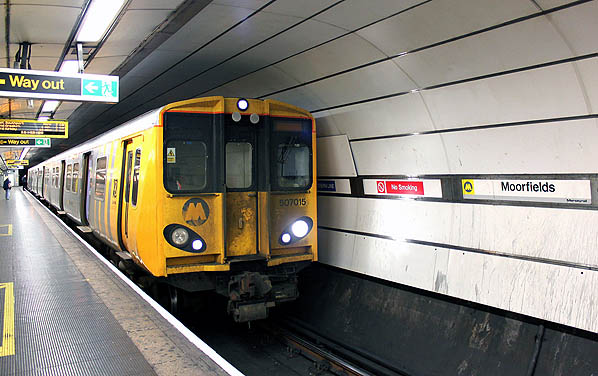
Photo by Zippy from his Flickr photostream
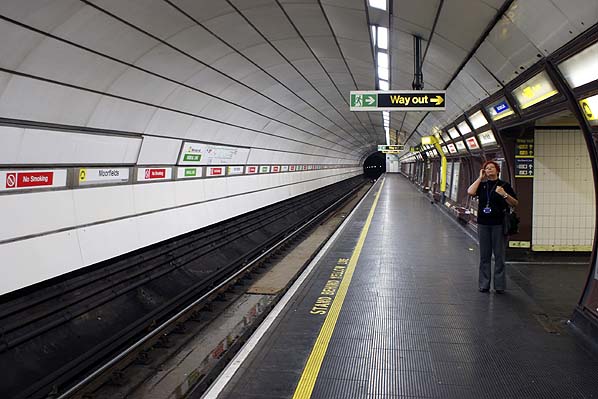
Photo by Paul Wright
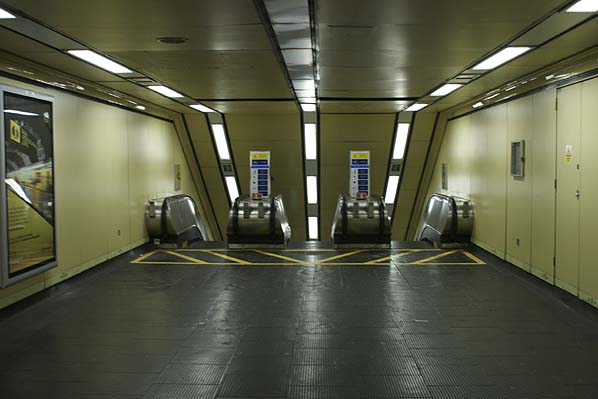
Photo by Paul Wright
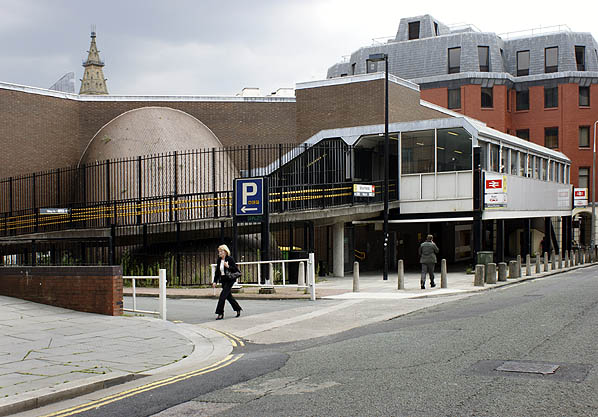
can clearly be seen
Photo by Paul Wright
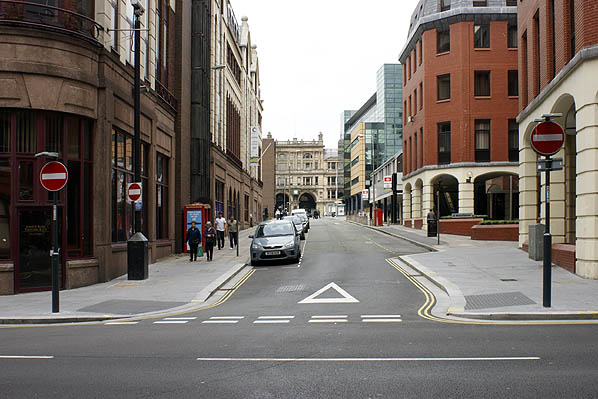
Photo by Paul Wright
| Last updated: Sunday, 21-May-2017 14:32:43 CEST |
© 1998-2011 Disused Stations
|
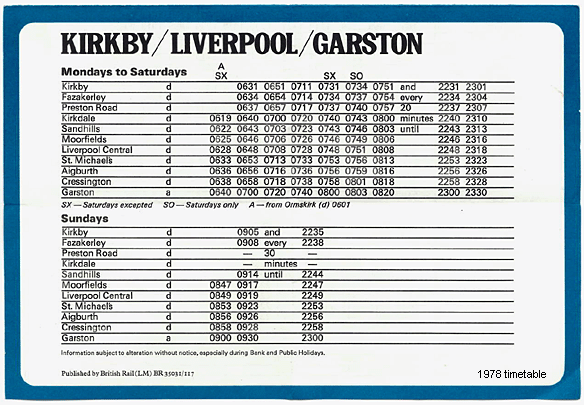

 Home Page
Home Page